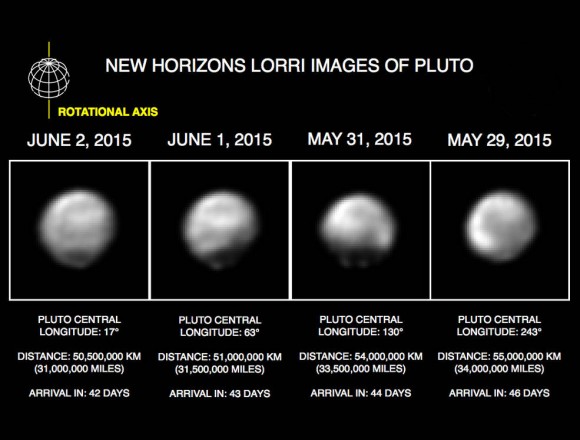
Pluto – once called the outpost planet because it was considered the most distant planet from our sun – hasn’t yet been seen close-up by any spacecraft. But the New Horizons spacecraft is now speeding toward this world, preparing to sweep past Pluto and its five known moons in July, 2015. The images on this page are the most recent released by NASA of Pluto. They are from New Horizons’ telescopic Long Range Reconnaissance Imager (LORRI), taken during May 29-June 11, and they show Pluto as a complex world with very bright and very dark terrain, and areas of intermediate brightness in between. These images offer the best views yet obtained of the Pluto system … but much-better views are coming soon!
Alan Stern, of the Southwest Research Institute, Boulder, Colorado is New Horizons Principal Investigator. Stern said in a statement from NASA on June 11, 2015:
Even though the latest images were made from more than 30 million miles away, they show an increasingly complex surface with clear evidence of discrete equatorial bright and dark regions—some that may also have variations in brightness.
We can also see that every face of Pluto is different and that Pluto’s northern hemisphere displays substantial dark terrains, though both Pluto’s darkest and its brightest known terrain units are just south of, or on, its equator. Why this is so is an emerging puzzle.

New Horizons scientists used a technique called deconvolution to sharpen the raw, unprocessed pictures that the spacecraft beams back to Earth; the contrast in these latest images has also been stretched to bring out additional details. Deconvolution can occasionally produce artifacts, so the team will be carefully reviewing newer images taken from closer range to determine whether some of the tantalizing details seen in the images released today persist.
By the way, Pluto’s non-spherical appearance in these images is not real; it results from a combination of the image-processing technique and Pluto’s large variations in surface brightness.
Since April, deconvolved images from New Horizons have allowed the science team to identify a wide variety of broad surface markings across Pluto, including the bright area at one pole that scientists believe is a polar cap.
New Horizons is approximately 2.9 billion miles (4.7 billion kilometers) from Earth and just 24 million miles (39 million kilometers) from Pluto. The spacecraft and payload are in good health and operating normally.
See the daily, raw images from New Horizons on this page
Enjoying EarthSky? Sign up for our free daily newsletter today!
The images in the video above show dramatic variations in Pluto’s surface features as it rotates. When a very large, dark region near Pluto’s equator appears near the limb, it gives Pluto a distinctly, but false, non-spherical appearance. Pluto is known to be almost perfectly spherical from previous data.

Bottom line: Images obtained by the New Horizons spacecraft May 29-June 2 show Pluto is a complex world with very bright and very dark terrain.











